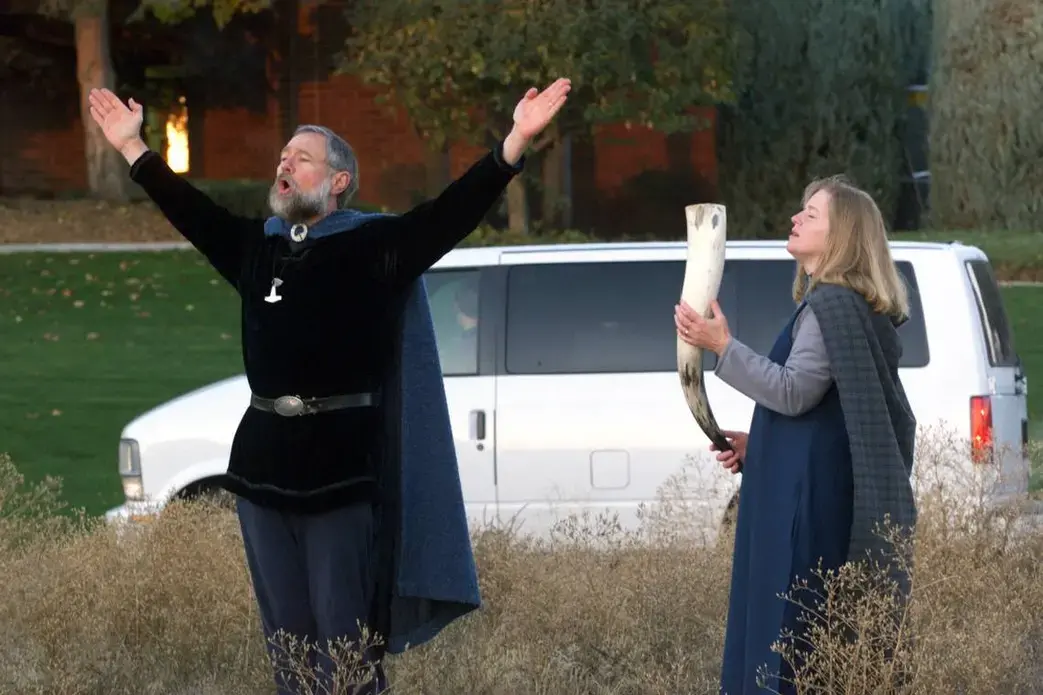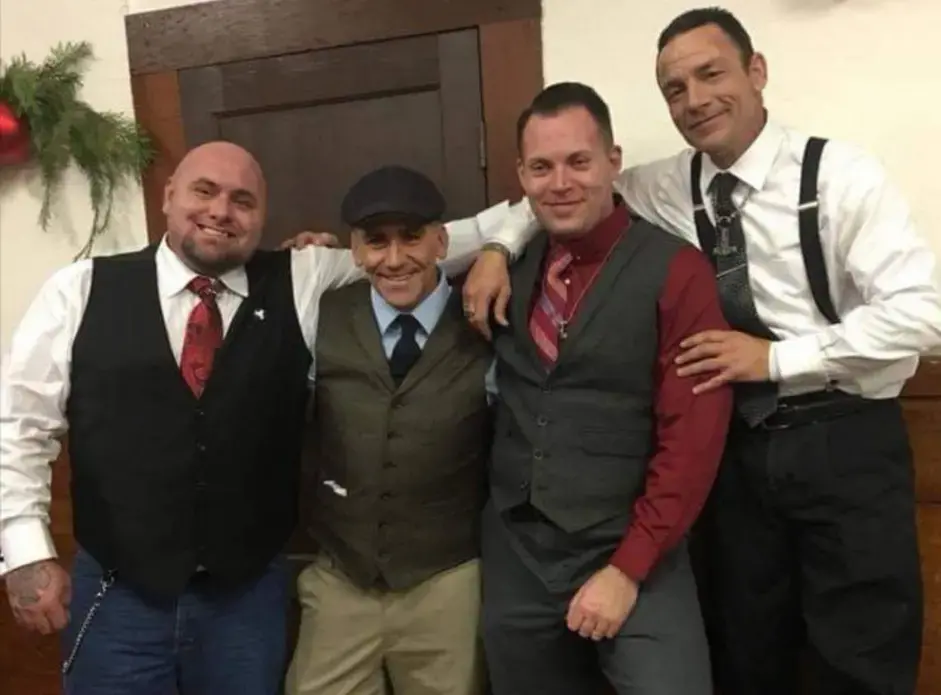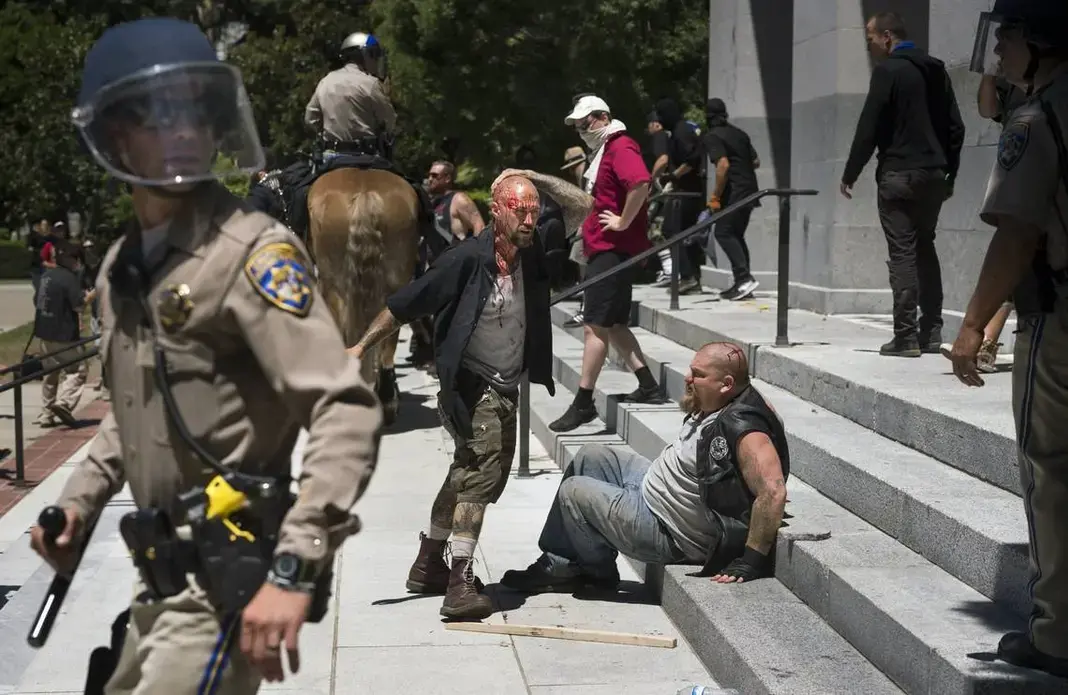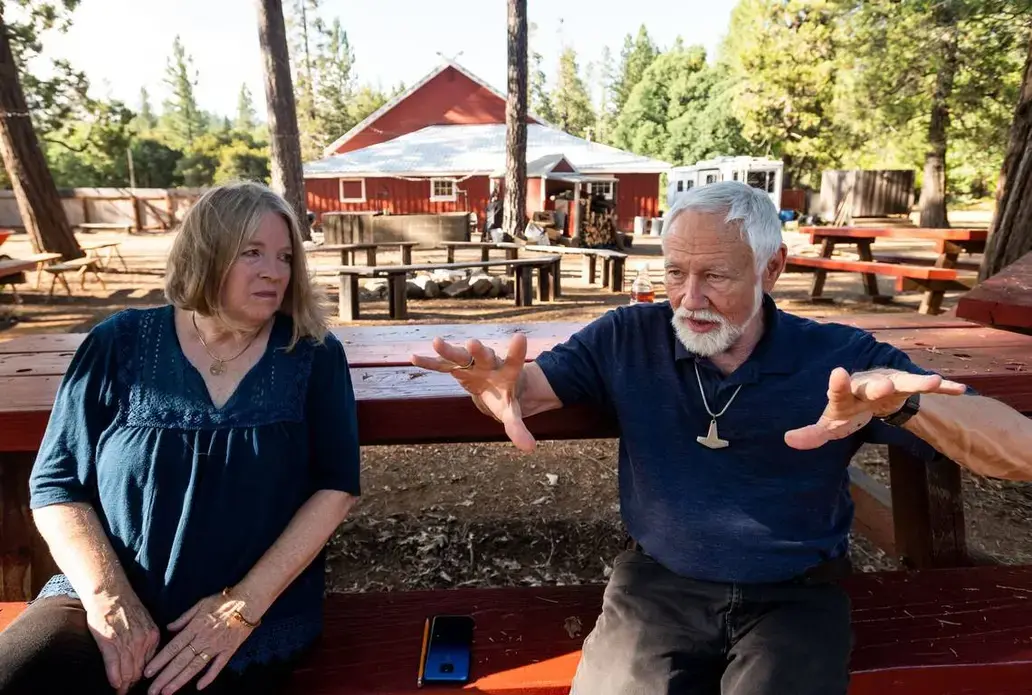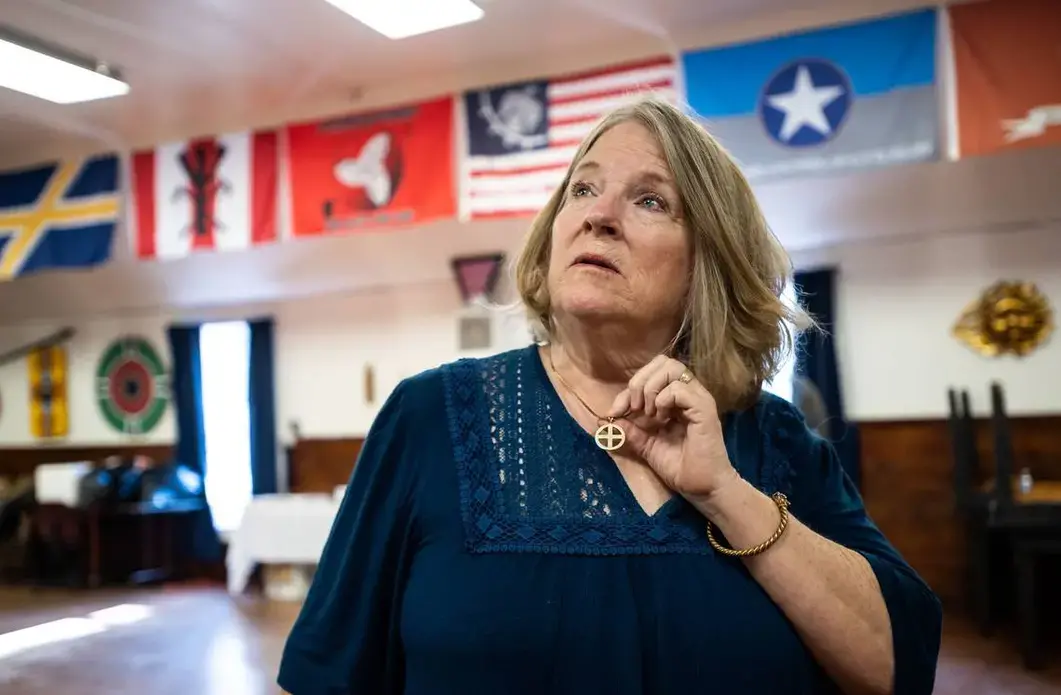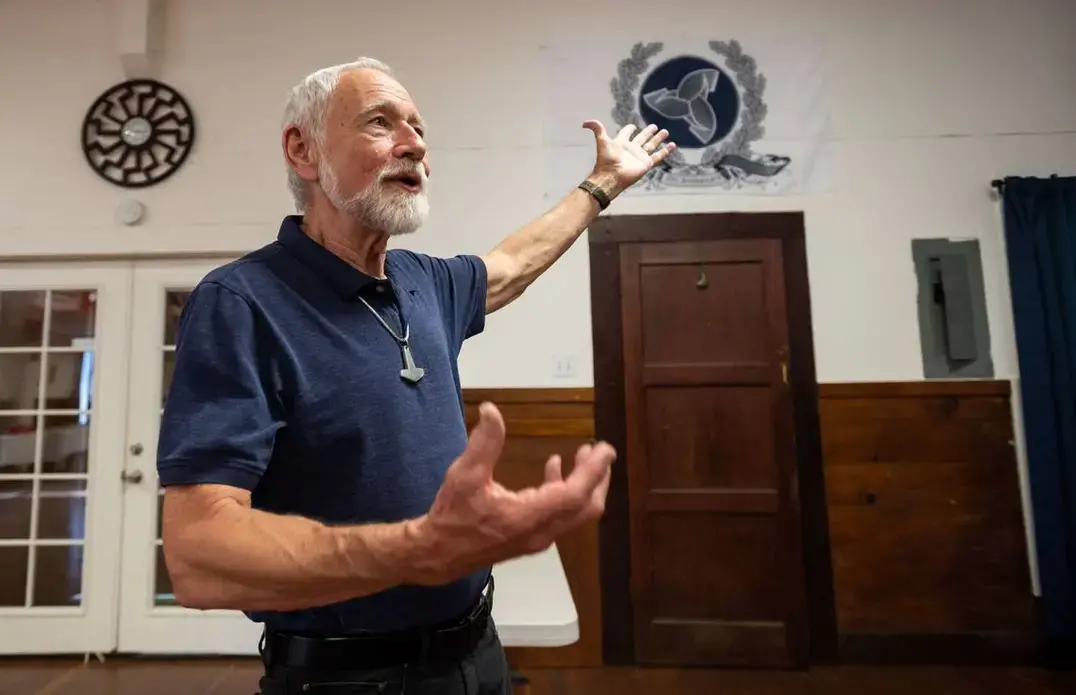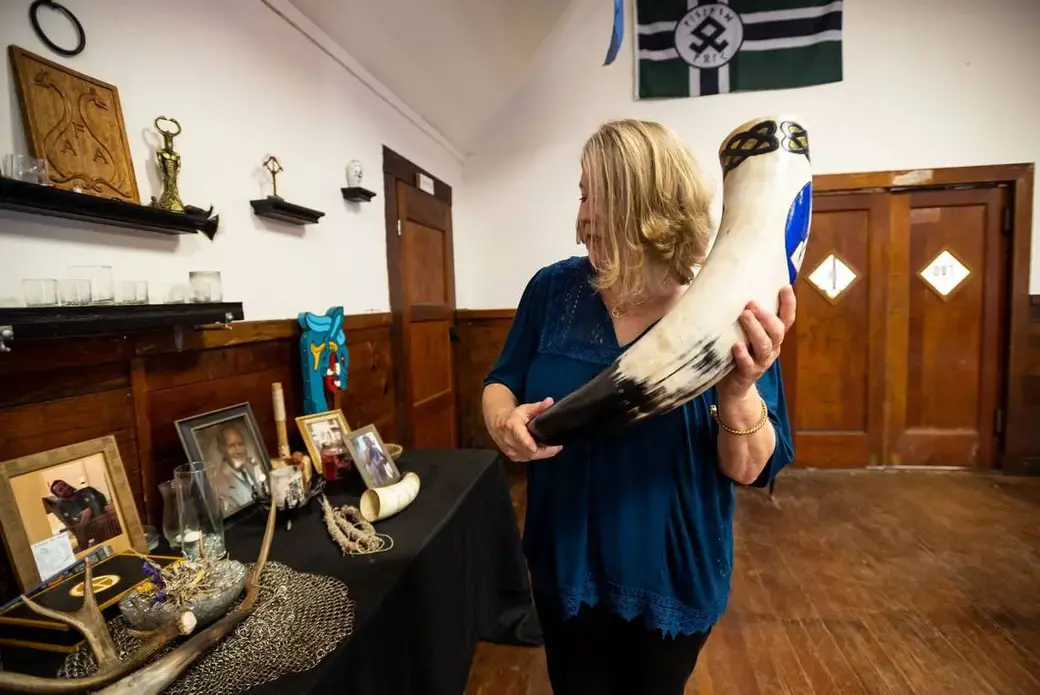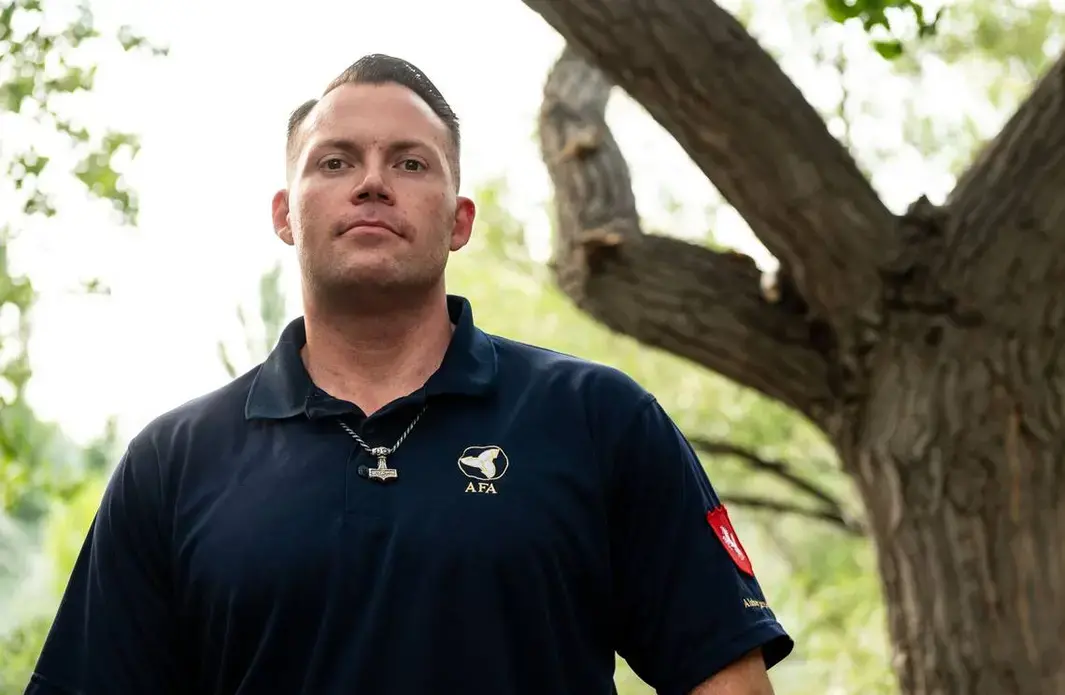Stephen McNallen’s path to founding a racist, whites-only church now headquartered in the foothills north of Sacramento started with fantasy novels and, eventually, found a measure of infamy through the discovery of an ancient skeleton.
McNallen, the 73-year-old founder of the Asatru Folk Assembly, was an avid reader of sword-and-sorcery novels like “Conan the Barbarian” when he was in college in the late 1960s in Wichita Falls, Texas.
One summer in a corner of a bookstore, he found something that would put him on the path to creating a U.S.-based church that worships Norse gods such as Thor and Odin and preaches a racial ideology so extreme the Southern Poverty Law Center has deemed it a hate group.
The book by Edison Marshall was called “The Viking” — historical fiction that became the basis for a 1958 film starring Kirk Douglas. The story centers around the expansion of Christianity in Northern Europe and its violent challenge to pagan Viking traditions.
“You had protagonists of both faiths contesting each other and interacting with each other,” McNallen said. “And by the time I finished that book, I knew which side I was on.”
Nearly three decades later, McNallen would have a revelation after a nearly 9,000-year-old skeleton was discovered in a shallow stretch of the Columbia River near Kennewick, Washington. “Kennewick Man” fascinated anthropologists, who at first believed he could have been part of an undiscovered race of people with caucasoid features who traveled to North America prior to the ancestors of Native Americans.
For McNallen, the bones proved that the white race — his “Folk” — had been in North America first and was wiped out by those who came later. Advances in DNA analysis proved McNallen wrong several years later, but that didn’t stop him from proselytizing that the white race is threatened with extinction.
Asatru’s 700 members also are taught that mixed-race families “are contrary to the values” of the church and transgender people have “a tragic mental illness.” Homosexuals are banned from the church “for the safety and health of our children,” according to Matthew Flavel, Asatru’s “Alsherjargothi,” the equivalent of the church’s high priest.
“Asatru” is an Icelandic word that McNallen said means “true to the gods.” Its adherents follow a so-called Statement of Ethics that suggests violence may be necessary to protect the Folk, which to the AFA unabashedly means white people.
“We believe that our members should strive to be ready for the challenge to defend our folk, Gods and Goddesses with both cunning and physical skill when needed,” it reads. “We should be prepared to stand against those forces which would seek to destroy our Gods and Folk.”
For decades, Asatru Folk Assembly has existed without much notice, just another fringe group in a state known for them. But that has changed in the past few years as Asatru has expanded its reach to a few other states and as white nationalists and other racist organizations have grown in number and influence throughout the country, reaching dangerous flashpoints with the violent “Unite the Right” rally in Charlottesville, Va., in 2017 and then the Jan. 6 riots at the U.S. Capitol.
McNallen said he was at Charlottesville “as an individual, with no connection to any of the organizations which were there.”
“My reason for going was that I have Confederate ancestors who fought honorably and whose blood was shed defending their homes,” he said. “I have no apology.”
McNallen has been warning about white people being replaced for decades, long before “white replacement” theory was pulled into the mainstream by far-right members of Congress and Tucker Carlson on Fox News — and before cries of “Jews will not replace us” and “You will not replace us” were chanted in Charlottesville.
No AFA member has been linked to an act of mass violence, but experts who study hate groups say the faith’s white replacement rhetoric is deeply troubling.
“If you have a person or a group who believe that whites are being replaced, that justifies and rationalizes all kinds of different types of behavior,” said Pete Simi, a sociologist at Chapman University and author of a book about the white power movement.
“From a white replacement perspective, you can justify those things — terrorism and hate crimes — as self defense, if that’s your perspective.”
‘VIKING BROTHERHOOD SECRET LAIR’
In interviews with The Sacramento Bee, Asatru’s leaders describe their faith as merely a way for white people to reconnect with an ancient belief system practiced by their European ancestors. They say they don’t advocate for violence, and they vet members to ensure violent extremists don’t hijack their faith.
“I don’t know of any cases — any, any cases — where our people have initiated violence or done anything of that sort,” McNallen said in an interview outside the “Odinshof” church in Brownsville, a pendant of Thor’s hammer hanging from a chain around his neck.
McNallen said he’s never left his conservative upbringing behind: “I have been anti-communist all my life.” But after discovering “The Viking” novel in the bookstore, he read through every book he could find on ancient Nordic people and their pagan beliefs.
At one point, he turned his college apartment into a clubhouse of sorts with the name “Viking Brotherhood Secret Lair and Stronghold” stenciled on the front door. Around his college graduation, McNallen began self-publishing his research and his thoughts on his emerging faith on a mimeograph under the title “Runestone,” which remains the name of the AFA’s website.
In the early 1970s, McNallen joined the U.S. Army, where he spent four years and said he became a member of the Rangers. Around that time, he started a nonprofit organization, then called Viking Brotherhood. McNallen changed the name to the Asatru Free Assembly a few years later. That group was disbanded in 1986 because of what McNallen described in his book as infighting and a shortage of funds to pay church leaders. McNallen started the current organization, the Asatru Folk Assembly, in 1994.
The Asatru Folk Assembly operated in obscurity and without a formal gathering place for years, with McNallen self-publishing his “Runestone” newsletters, writing his book, “Asatru: A Native European Spirituality,” and running a lightly trafficked website from his home in Nevada City, Calif.
That changed in 2015 when Asatru bought the grange hall in Brownsville and named it “Odinshof.” The church sits in the brush — and oak-covered foothills of Yuba County about a 90-minute drive north of Sacramento.
Asatru has recently expanded elsewhere in the U.S., with considerable local controversy. The church opened two houses of worship that members call “Hofs” in Minnesota and in North Carolina. Asatru leaders say they’re going to expand into another undisclosed state soon, and they’re looking for a new location.
Residents in Linden, N.C., in a county where 1 in 3 people is Black, were appalled that the whites-only faith had moved into an abandoned Methodist church last year. To Black community leaders, the arrival of a whites-only church brought traumatic memories of slavery, the Ku Klux Klan and the racially segregated South.
In Murdock, Minn., a group of neighbors in the quiet farm town of 280 people pleaded last year with the city council to reject the AFA when its leaders applied for a conditional use permit to turn a vacant Lutheran church into its next Hof, “Baldurshof.”
The council ultimately said it had no choice but to approve the permit, because the church wasn’t violating any of the town’s zoning ordinances. The city’s legal advisers worried Murdock could lose a religious discrimination suit, according to local news accounts.
Pete Kennedy, one of the residents who urged the council to block the church, told The Bee that, so far, the Asatru Folk Assembly has stayed quiet, and he doesn’t believe any local residents have joined the faith.
His hope is that Murdock’s 120-mile distance from any major city will make it such a burden for Asatru members to travel that the church eventually goes back to being vacant.
“It’s not a good thing for Murdock to be known for, that this group is here, whether they’re really that active or not,” he said. “Murdock is the place where the white supremacists are, and we don’t really want to be known for that.”
Lately, the church has been reaching out to the local communities. The AFA regularly hosts food giveaways at its Hofs. Stephen McNallen’s wife, Sheila, said the church plans to give away presents to local kids next month.
Some are skeptical of their intentions.
“I think that there is possibly efforts to try to soften down the racism and the vitriol and the hatred, to put a different shade on it by trying to be helpful in the communities,” said Tracy Pepper, founder and executive director of Color Me Human, an anti-racism group in nearby Nevada County. “I’m grateful to hear people in the community have an opportunity to get food, but I’m very suspicious of the motives.”
Simi, the Chapman University hate group expert, said doing charitable works and offering public statements espousing non-violence are how white supremacists — from KKK leader David Duke to the people behind the violent “Unite the Right” rally in Charlottesville — try to distract from their dangerous, hate-filled beliefs.
“‘White civil rights.’ ‘European heritage.’ ‘We just love our people.’ ‘We don’t want any harm to anyone.’ That’s the front stage,” Simi said.
“Backstage, what do you find? You find a very different way that people present themselves and talk and other things that they advocate for. Frankly, that backstage is pretty ugly, and it’s filled with hatred.”
‘THE CHURCH IS EVERYTHING TO THEM’
Records obtained by The Bee through the Freedom of Information Act show that for a time in 2002, the FBI investigated the AFA after getting reports from the California Highway Patrol office in Grass Valley that its leaders were “actively recruiting young white males and females to their ‘church.’"
The matter was quickly closed, with the FBI agent citing “lack of criminal activity.” The heavily redacted investigative narrative includes a two-page printout from a section of Asatru’s website titled “Building tribes and walking the spiritual path of our ancestors.”
“WE ARE NOT racist (unless being of European heritage and not hating yourself is racist),” it reads. “We are opposed to racial hatred and intimidation, regardless of who practices it. … HAVING SAID THAT, we might add that we are not pitiful ethnomasochists, cringing before the court of the politically correct, ready to apologize for living.”
In recent years, local anti-fascist activists and online sleuths have linked Asatru to Northern California hate groups.
On its website, Antifa Sacramento outed Asatru member Marc Macleod, who lives in the Sacramento area, as someone with close ties to local neo-Nazi groups. Macleod was listed in 2019 on the church’s website as coordinator of Asatru’s “Folkbuilders,” church members “who organize events, answer questions and build the evolving Asatru community,” according to McNallen’s book.
Sheila McNallen said this summer that Macleod doesn’t hold the title Folkbuilder coordinator anymore, but he does manage the Odinshof in Brownsville.
Antifa unearthed social media photos showing Macleod posing in 2017 in front of the Confederate monument in Stone Mountain, Ga., where the Ku Klux Klan once held cross burnings. Macleod declined an interview request.
“This is the only thing they do, their church,” Sheila McNallen said of Macleod and his then-fiancée, Deedy Rutherford. “They don’t do anything political. Well, they were Trump supporters. On the Fourth of July, you’d see that they were all decked out in red, white and blue. That’s them. They’re true patriots. That’s it. This, the church, is everything to them.”
In other photos Antifa Sacramento uncovered, Macleod can be seen with Jonathan Jordan and Joseph Simmons, two Sacramento-area residents who were part of a group of white supremacists calling themselves the Traditionalist Worker Party. The group violently clashed with Antifa activists at the state Capitol in 2016 in Sacramento. Similar photos also are included in court files.
The Traditionalist Worker Party advocated for racially pure nations and communities and blamed Jews for many of the world’s problems, according to the Southern Poverty Law Center and other hate group experts. It was among the groups that organized the “Unite the Right” rally in Charlottesville.
In one of Antifa’s photos, Jordan gives a Nazi salute on the Capitol steps in Sacramento. Other photos obtained by The Bee from the criminal case following the brawl show a California Highway Patrol officer escorting Jordan from the fighting a short time later with a bloody head wound. Jordan couldn’t be reached for comment.
At one point after the brawl, the CHP recommended charging Simmons based on footage showing him holding a large knife during the fighting, according to court records in the case. Simmons, who also is pictured posing at Stone Mountain, wasn’t charged.
Sacramento County criminal court records list Simmons as having “Skinheads” as an alias. He didn’t return a phone message from The Bee.
In another photo that Antifa Sacramento pulled off of social media, Simmons can be seen inside Asatru’s Odinshof in Brownsville with Macleod. They’re wearing ties and vests. Simmons has his arm around Macleod and another man — Flavel, Asatru’s Alsherjargothi, who is grinning alongside them.
In the past few years, Flavel has taken over from Stephen McNallen to run the day-to-day operations at the AFA.
Flavel, who lives in Reno, Nevada, downplayed the photo of him with Simmons, which he called a “guilt-by-association thing.”
“We’re a church,” he told The Bee during an interview at a Reno park. “We have people who have lived all kinds of different lives and are involved in all kinds of different politics. We’ve got all sorts of different people with different backgrounds that come to our events and interact with us.”
Asked about the photos and whether neo-Nazis are welcome in the Asatru Folk Assembly, Flavel said, “The AFA does not dictate who our members take pictures with, nor do we dictate what political parties members are allowed to join or involve themselves with.”
The McNallens also said they don’t shun former skinheads. Instead, they said, they hope a “personal evolution” toward self-betterment that they claim is central to their faith will encourage them to leave their hate-filled beliefs behind.
“That’s what we want,” Stephen McNallen said. “We want them squared away. Get off the hate trip. Don’t hate other people. Love your people. Fix your life.”
‘WE’VE HAD GUYS LOSE THEIR JOBS’
Lately, some members of the military and law enforcement have faced repercussions for being members of the church.
In Virginia, a police officer was fired from his department in 2019 after local anti-fascist activists shared photos showing his affiliation with the church. Two members of the National Guard from Georgia were discharged after activists revealed their ties to the AFA.
“We’ve had people constantly doxxed,” McNallen said. “We’ve had guys lose their jobs. We’ve had people that can’t sell vegetables in the local vegetable market. … They go down to sell their freakin’ vegetables. We’re not talking, you know, swastika banners and KKK signs.”
In 2019, a gunman in Christchurch, New Zealand, killed 51 people and wounded 40 others in two mosques. His manifesto, which was adorned with ancient Norse symbolism, was titled “The Great Replacement” — another reference to the conspiracy theory that whites are being forced aside in their home countries by other racial and religious groups.
Fear of “replacement” also is a key theme in other mass shooters’ manifestos, including the man who targeted Hispanics in El Paso, Texas, and the Tree of Life and Poway synagogue gunmen.
The New Zealand online publication Stuff linked the Christchurch shooting to a group of AFA-affiliated members who lived in the area, focusing on the similarities between the shooter’s and the groups’ beliefs.
The leader of the affiliated group, along with Stephen McNallen, Macleod and other AFA members, filed complaints with New Zealand’s Media Council, a news industry-appointed body that serves as an arbiter for disputes over press fairness and accuracy. They argued that the piece was inaccurate and unfair.
The council upheld one complaint made by the affiliated group, saying the article did unfairly link that group to the shooting. But the council didn’t uphold the remainder of the complaints, saying the publication reported reputable sources that linked the AFA outside of New Zealand with right-wing violence.
“It was appropriate that, in the context of the Christchurch shootings,” the ruling found, “it should investigate the New Zealand connection of the organisation.”
A 'MYTHICIZED VIEW' OF HISTORY
The Asatru Folk Assembly is the largest of several so-called “Neo-Völkisch” organizations that, according to the Southern Poverty Law Center, “attempt to cloak their ethnic exclusivity in claims centering on the victimization of white people, while other groups overtly promote racial supremacy.”
The AFA isn’t the only religious group that worships the Norse gods, but many of those say they do not embrace McNallen’s whites-only brand of paganism. The founders of more inclusive pagan churches have condemned and distanced themselves from the AFA and other similar faiths.
“They really look down on these, what they call the Nazis and neo-Nazis, trying to hijack their faith,” said Lowell Smith, a former Orange County probation officer who is a consultant on white supremacists, white nationalists and anti-government groups.
Still, the racial religious concepts that McNallen has been promoting since the 1970s remain popular in much of the wider Asatru community in the United States, said Karl Seigfried, a practicing pagan and adjunct professor at the Illinois Institute of Technology.
“Even groups that publicly declare that they’re ‘not racist’ and distance themselves from the AFA often share concepts such as a mythicized view of northern European history, focus on ancestry in terms of Blut und Boden (‘blood and soil’), and mystical practices derived from the German völkisch occult,” Seigfried wrote in an email.
“Some of these groups have had overlapping membership with the AFA, even at the leadership level, so the problem is much larger than it may seem to non-practitioners.”
One of the most notorious figures to worship Norse gods was David Lane, a member of the neo-Nazi terrorist group The Order, according to the Southern Poverty Law Center. In 1984, Lane drove the getaway car when other members of The Order assassinated Jewish radio host Alan Berg in Denver.
Lane died in prison in 2007 but not before he wrote a series of racist tracts and propaganda, which, according to the Southern Poverty Law Center, included what became an iconic slogan of the U.S. white supremacist movement — the so-called “14 Words”: “We must secure the existence of our people and a future for White children.”
McNallen said his group doesn’t practice racial supremacy, and he’s “not particularly a fan of David Lane.” But McNallen has his own eight-word slogan that is similar to Lane’s.
“I think we are concerned about the long-term prospects for our people,” McNallen said. “We see more and more homogenization. We see more and more lack of concern for what to us are very, very primal issues. That’s my ‘Eight Words’: The existence of my people is not negotiable.”
He quickly added: “But anyone of any race or any tribe — any level you care to break it down into — could say that.”
Flavel, the AFA’s Alsherjargothi, said both Lane’s and McNallen’s credos “are beautiful as stand-alone statements. Agreeing with a particular slogan or quotation does not imply agreement with the totality of an author’s ideology.”
McNallen insisted that every faith should be allowed to practice its ancestral religions and exclude others based on their racial heritage.
“I can’t join an Indian tribe,” McNallen said. “I can’t get access to their inner rituals. I can show up at a powwow, and then when the dancing for the public is over and they go off to do Indian things, they kind of gently escort you out.”
Christopher Towler, an assistant professor at Sacramento State who has studied far-right extremist movements, said the comparison is nonsense.
“Whites, especially white churches, have always had the opportunity to self-segregate, where Black churches were forced into segregation,” Towler said. “It was in response to slave codes and a history of Black people not even being able to practice faith and religion openly in this country for hundreds of years.”
When Towler hears white people say they’re worried about being replaced, he said, “It’s really about the fear of losing white power, white status and white privilege more than anything else.”
CLAIMS THAT AFA SHUNS ANY TALK OF VIOLENCE
After Facebook and Instagram banned the AFA and its leaders from their sites in recent years, the church saw a marked drop in new growth.
Asatru still maintains a presence on Twitter, Telegram and YouTube. Flavel regularly holds live question-and-answer sessions on YouTube with AFA members and others interested in the faith. The church also shares interviews that he and McNallen have done with various groups.
In May, Flavel posted on YouTube an interview he did on a podcast co-hosted by Jason Köhne, the founder of a website called Nowhiteguilt.org. Flavel’s message was clear: The AFA is a place for “traditionally-minded” white people who feel disenfranchised in a rapidly changing society.
“In the past few years, it has been pretty much a war on anything that, you know, our grandparents would have found moral and upright and valuable. And so a lot of people have come because of that,” Flavel told the hosts.
The McNallens said AFA leaders monitor the church’s Telegram chat channels, making sure to root out “accelerationist” talk from people who are seeking to start a race war or commit some other act of violence.
“We have a zero tolerance for that if we detect it,” Stephen McNallen said. “I have never detected any of it. … But we watch, because we know they’re out there.”
Nevertheless, AFA’s Statement of Ethics says that the Folk should be prepared to use “both cunning and physical skill” to defend themselves. McNallen said that means church members will defend themselves “if Antifa wants to come through and rumble.”
“It can be verbally. It can be responding to stuff like the accusations,” he said. “That’s defending our Folk. That doesn’t mean ‘Let’s go out and beat anybody up.’ That would be totally dishonorable.”
HOW ‘KENNEWICK MAN’ INFLUENCED THE AFA
Stephen McNallen’s “proof” his white ancestors were wiped out in North America once before came in 1996, when a couple of college students watching a boat race found a human skull in a shallow stretch of the Columbia River near Kennewick.
Local authorities who collected the skeleton realized it was old, but the skeleton’s facial features didn’t appear Native American, so they assumed it was a white settler to the region. They labeled the bones as having “caucasoid” features.
Scientists were floored when the carbon dating on a piece of the skeleton came back. It was nearly 9,000 years old, making it one of the oldest complete skeletons found in North America.
The man had lived a violent life. Researchers discovered a spear point lodged in his hip. The bones had long since healed around the stone blade. He had two skull fractures, indicating he might have been bashed in the head. Five broken ribs on his right side never properly healed.
“Kennewick Man,” as he became known, became a national sensation when a forensic reconstruction of the man’s face showed he looked eerily like Patrick Stewart, the English actor best known for playing Capt. Picard on “Star Trek: The Next Generation.”
The discovery fascinated anthropologists, some of whom believed the skeleton could be part of an undiscovered race of people who traveled to North America apart from those who walked from Asia across the land bridge during the last Ice Age.
But local Native American tribes insisted he was their ancestor and demanded the bones be returned to them for a proper burial.
McNallen joined the legal fight against that. He and the AFA filed a lawsuit demanding to be included in the discussion of what to do with the remains. McNallen became a cause célèbre among the white nationalist movement.
“I think that Kennewick Man has come back to remind us that our position on this continent is vulnerable,” McNallen said to applause in a presentation he gave on a cable access program hosted by Canadian Holocaust denier Ernst Zundel.
“But unless we sink our roots deep into this soil, we will be displaced. What happened to his people can happen to our people. And I’m telling you now that I, for one, am not in a mood to permit it.”
But, as it turned out, Kennewick Man’s people weren’t replaced by anyone, nor was he even Caucasian. After two decades, advances in DNA technology settled the matter for good and cast doubt on the practice of using skull measurements to make scientific determinations of racial heritage. Researchers used DNA taken from a hand bone to conclusively prove that Kennewick Man’s closest modern-day relatives are the Colville Tribes of Eastern Washington.
Native Americans buried his remains at an undisclosed location in February 2017. Around 200 members of five Columbia Basin tribes attended the burial.
Andy Joseph Jr., the chairman of the Colville Tribes, said that when the DNA results conclusively showed Kennewick Man was an ancestor of his people, it was a vindication of the truth behind the oral histories they had been sharing for eons.
He said it was an incredibly moving experience to put Kennewick Man’s remains to rest as his descendants looked on.
“Our tribe was really happy with the outcome,” Joseph said. “He is re-buried and put back into the ground at a place that we will never disclose. Hopefully, he’ll never, ever be unearthed again. We wouldn’t want to go digging up anybody else’s elders.”
Despite the scientific evidence, McNallen is skeptical. He thinks the sample used to take DNA might have been contaminated, and he still suspects that Kennewick Man might be “distant kin.”
“I have some doubts about the DNA analysis that said that the closest relatives were members of one of the local tribes, because those tribes have moved around a lot in the last X-number of thousands of years,” he said. “But, you know, hey, whatever. … We’re not going to beat that drum.”
Asked about McNallen using the tribes’ ancient ancestor to make a case about white oppression, Joseph brought up a litany of genocidal, oppressive things white people did to native North American tribes — notably, taking children from their parents and forcing them into boarding schools, cutting their hair and beating them for speaking their native language.
“I don’t think they should use the Kennewick Man for anything,” he said. “He (McNallen) should be looking at his own ancestors, and that would be the oppression that he is suffering from.”




